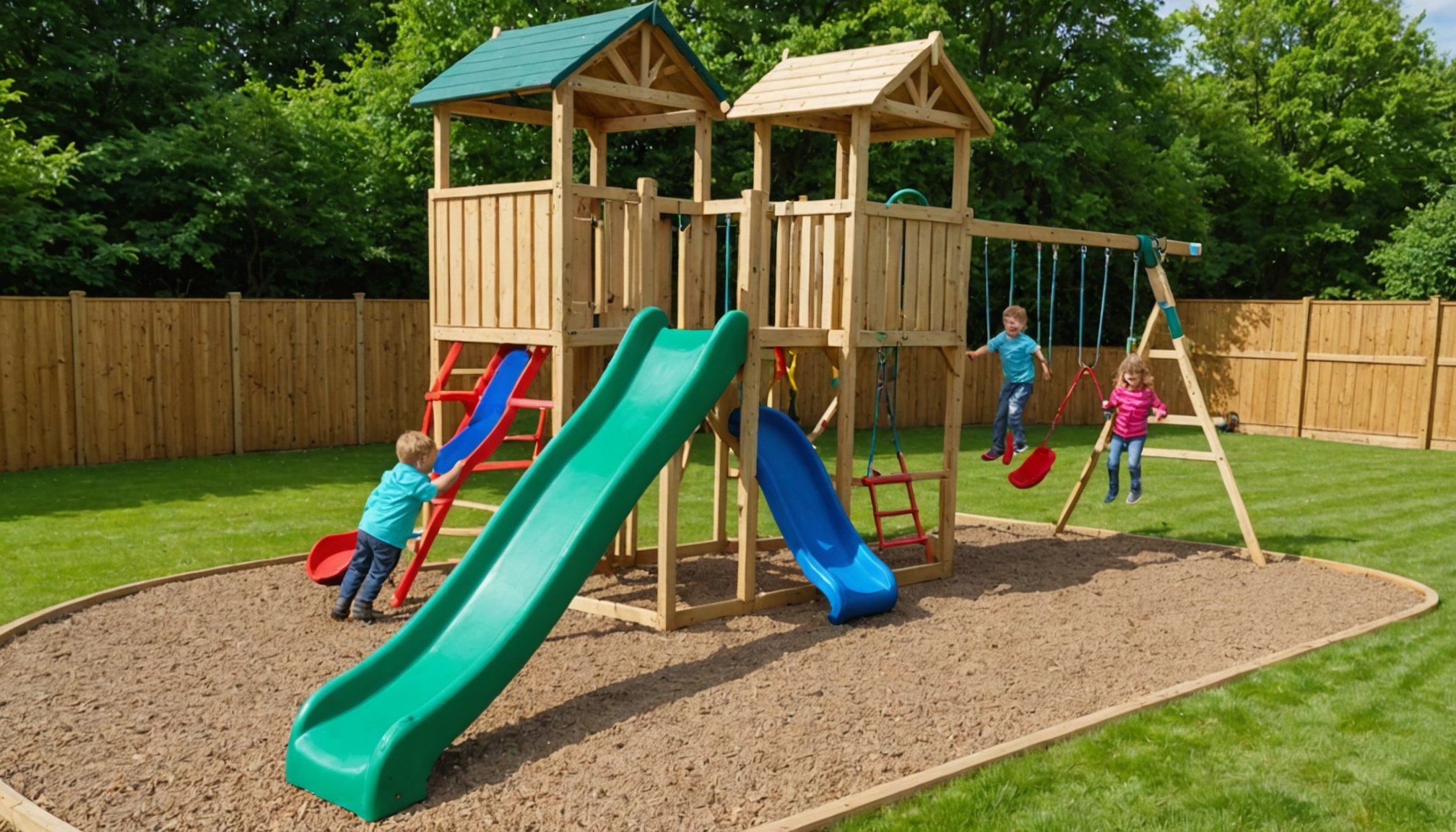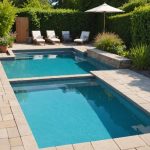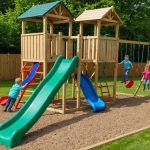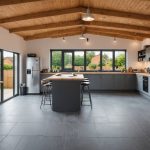Creating a secure and enjoyable play area for children requires thoughtful planning and consideration. Parents in the UK face unique challenges, from weather to safety regulations, but transforming your backyard into a vibrant play zone is achievable with the right tips. Explore innovative ideas that engage kids while prioritising safety. Discover how to integrate fun elements like climbing frames, swings, and sensory gardens, ensuring your outdoor space is both a sanctuary and an adventure zone for your little ones.
Importance of Safety Standards in Backyard Play Areas
Ensuring child safety in backyard play areas is crucial, and adhering to UK regulations is an essential step. These regulations provide guidelines to create safe environments for children to enjoy outdoor play. They cover various aspects, including the design, installation, and maintenance of play equipment.
A lire en complément : Transforming Your Garage into a Legal Living Space: A Comprehensive Guide for Homeowners in the UK
One key element is the requirement for safety surfacing. This involves using materials like rubber mulch or sand beneath play equipment to cushion falls and reduce injury risks. The depth and type of surfacing are specified to ensure maximum protection.
Additionally, equipment standards are enforced to prevent accidents. This includes ensuring that swings, slides, and climbing frames are constructed with durable materials and are free from sharp edges or pinch points. Regular inspections are mandated to identify potential hazards and address them promptly.
Sujet a lire : Ultimate Guide to Creating Your Own Rainwater Harvesting System for Your UK Garden
To maintain safety, it's advisable to conduct regular safety inspections. By checking for wear and tear, loose bolts, or damaged parts, you can prevent accidents before they occur. Maintenance should be a routine practice, involving cleaning, repairing, and replacing equipment as needed.
By prioritising safety standards and following UK regulations, you create a secure and enjoyable play environment for children, fostering their development and happiness.
Choosing the Right Equipment for Different Age Groups
Selecting age-appropriate play equipment is vital for ensuring both safety and enjoyment in children's playgrounds. Each age group has unique needs and abilities, and catering to these can enhance their play experience.
For toddlers and preschoolers, equipment should focus on safety and sensory exploration. Recommended items include low slides, small climbing structures, and interactive panels. These options encourage motor skills development while ensuring that young children are not exposed to high-risk activities.
When considering primary school-aged children, the equipment should be more challenging to match their growing physical abilities and adventurous spirit. Climbing walls, monkey bars, and balance beams are excellent choices. These structures help in developing strength, coordination, and confidence.
Investing in multi-use equipment can be beneficial as it adapts to your child's growth. Structures that can be adjusted or expanded as your child grows provide long-term value and keep the playground engaging. Look for equipment that offers varying levels of difficulty or can be reconfigured to suit different age groups.
By choosing the right equipment for each age group, you ensure a safe, stimulating, and enjoyable play environment that supports your child's developmental needs.
Creative Landscaping Ideas for Play Zones
Designing an outdoor play area goes beyond equipment selection; it involves thoughtful landscaping to enhance the play experience. Incorporating natural elements like trees and shrubs can provide both shade and interactive play opportunities. Trees not only offer a cool retreat during sunny days but also serve as great spots for imaginative play, like hide-and-seek or tree climbing for older children.
Creating distinct pathways and zones within the garden can help organise different activities. Consider using materials like wood chips or stepping stones to define paths that lead to various play zones. This can encourage children to explore and engage with different parts of the garden, promoting both physical activity and creativity.
Integrating water features or sensory gardens can add an exciting dimension to the play area. A small, shallow pond or a water table can provide hours of fun while teaching children about nature. Sensory gardens, filled with plants of various textures, colours, and scents, can stimulate curiosity and learning.
By combining these landscaping ideas with thoughtful outdoor play area design, you can create a dynamic and engaging environment that supports children's development and keeps them entertained for hours.
Budgeting for Your Backyard Play Zone
Creating a cost-effective play area in your backyard requires careful budgeting and financial planning. Start by estimating the costs for equipment and installation. Consider factors such as the type of equipment, the materials used, and the complexity of installation. These elements can significantly impact your budget, so it's crucial to research and compare prices from various suppliers.
When planning your spending, prioritize based on your child's age and how frequently the play area will be used. For younger children, focus on essential safety features and basic equipment. As children grow, you can gradually invest in more advanced structures. This approach ensures that you are spending wisely and adapting the play area to your child's evolving needs.
Exploring funding options can also help manage costs. Look into grants or community projects that support the creation of play areas. Some local councils or organizations offer financial assistance for initiatives that promote children's outdoor play.
By strategically planning your budget and exploring available funding, you can create a safe and enjoyable play zone without overspending. This thoughtful approach ensures that your investment supports your child's development and provides lasting value.
DIY Options for Custom Play Structures
Creating DIY play equipment can be a rewarding hands-on project, allowing you to tailor your backyard to your child's preferences. With a few materials and tools, you can build custom playgrounds that are both safe and fun.
Step-by-step Guides for Building Simple Play Structures
Begin with a clear plan. Identify the type of structure you want, such as a swing set or a climbing frame. Look for detailed tutorials online that provide step-by-step instructions. These guides often include diagrams and lists of necessary materials, making it easier to follow along.
Safety Tips for DIY Construction
Safety should be your top priority. Ensure that all structures are stable and securely anchored. Use non-toxic, weather-resistant materials to withstand outdoor conditions. Regularly inspect your creations for wear and tear, and make repairs as needed.
Recommended Materials and Tools for Backyard Projects
Opt for durable materials like treated wood or metal for the main framework. For safety surfacing, consider rubber mats or sand to cushion falls. Essential tools include a saw, drill, and measuring tape. Investing in quality tools can make the construction process smoother and more efficient.
By embracing DIY projects, you can create a custom play area that meets your family's unique needs and preferences.
Themes and Creative Ideas for Play Areas
Creating themed play zones can transform a backyard into a world of imagination and adventure for children. By incorporating elements like pirate ships or fairy gardens, you can craft a unique environment that captivates young minds. These themes can be tailored to a child's interests, providing a personalized play experience.
Imaginative Design Concepts
Imaginative design is key to developing engaging play spaces. Consider adding elements such as castles, jungle gyms, or space stations to spark creativity. These structures not only offer physical challenges but also serve as a backdrop for imaginative play, allowing children to invent stories and adventures.
Incorporating Art and Creativity
Integrating art into play areas enhances their appeal and educational value. Install chalkboards or mural walls where children can express themselves through drawing and painting. These creative outlets encourage artistic development and provide a dynamic space that evolves with the child's interests.
Engaging Children in the Design Process
Involving children in the design of their play space can lead to more personalized spaces. Encourage them to share ideas and preferences, which can be incorporated into the final design. This engagement fosters a sense of ownership and pride, making the play area even more special and meaningful.
Adapting Play Areas for UK Weather Conditions
Creating a functional and enjoyable outdoor play area in the UK requires careful consideration of the climate. Selecting weather-resistant play equipment is crucial, as it ensures durability and safety throughout the year. Opt for materials like treated wood, metal, or high-quality plastic that can withstand rain and fluctuating temperatures without deteriorating.
To promote outdoor play in rain, consider adding sheltered areas. Structures such as pergolas or gazebos provide protection against the elements, allowing children to play outside even during wet weather. These areas can be equipped with waterproof seating and play items, ensuring comfort and safety.
Seasonal considerations are also essential when designing a play area. Incorporate features that make the space usable throughout the year. For instance, in colder months, installing outdoor heaters or windbreaks can extend playtime. In the summer, shade structures or sun sails protect against UV rays, keeping the environment safe and pleasant.
Encourage year-round outdoor play by designing versatile play zones that adapt to different seasons. This approach not only maximises the use of the space but also supports children's development by providing continuous opportunities for physical activity and imaginative play regardless of the weather.
Resources and Suppliers for Backyard Play Zone Essentials
Creating an engaging and safe backyard play zone requires access to reliable suppliers and resources. In the UK, several trusted suppliers offer a wide range of playground equipment and materials. Companies like Wicksteed, Playdale, and Sovereign have established reputations for providing high-quality, durable equipment suitable for various age groups. These suppliers often offer customization options, allowing you to tailor equipment to your specific needs.
For those seeking design inspiration or planning to embark on DIY projects, online resources can be invaluable. Websites such as Pinterest and Houzz provide a plethora of ideas and tutorials for creating unique play spaces. These platforms offer insights into current trends and innovative designs, helping you craft a play area that is both functional and visually appealing.
Engaging with community groups and forums can also enhance your planning process. Platforms like Mumsnet and Netmums host discussions where parents share experiences and advice on building and maintaining play zones. These communities can offer practical tips and firsthand reviews of equipment and suppliers, ensuring you make informed decisions. By leveraging these resources, you can create a play environment that is safe, enjoyable, and tailored to your child's needs.











